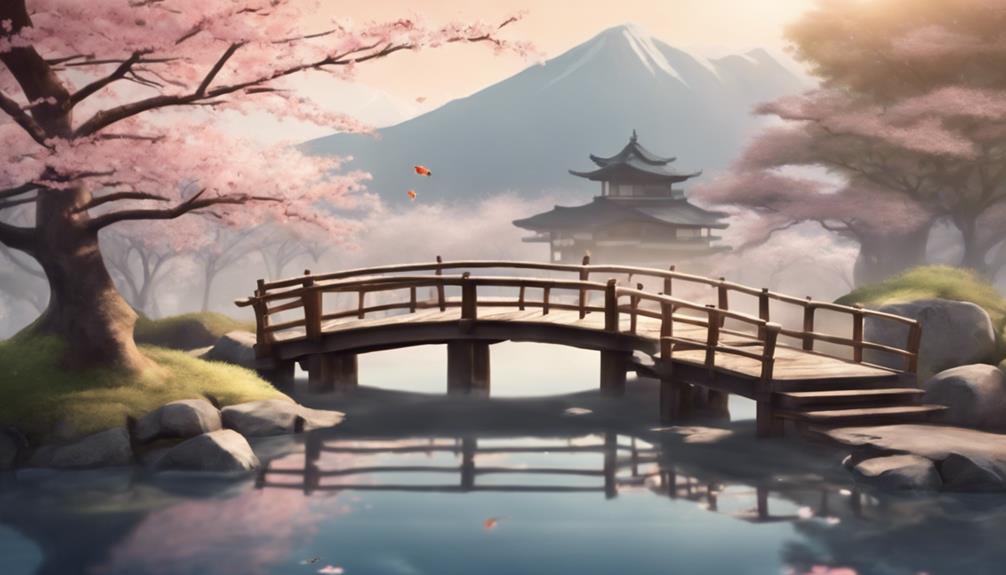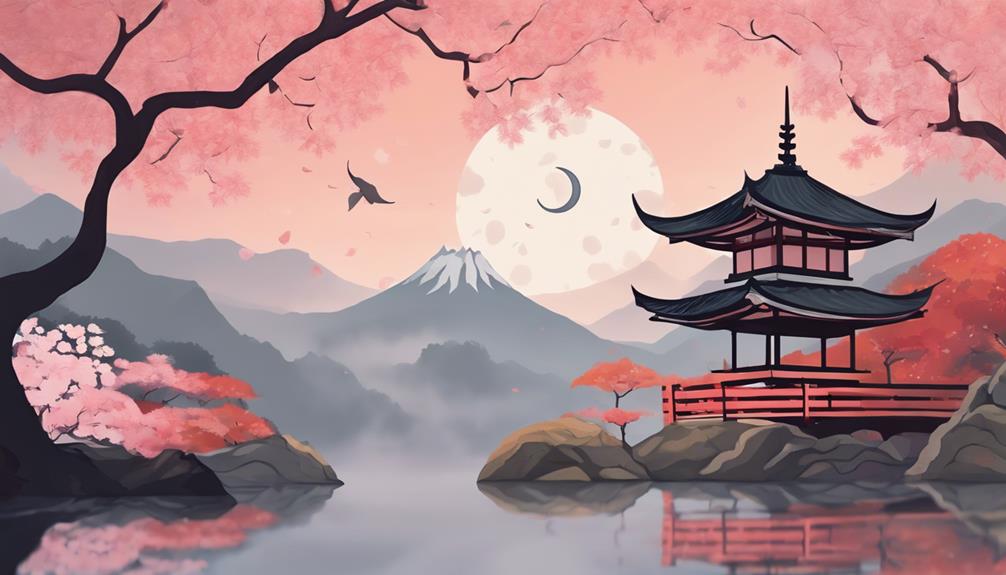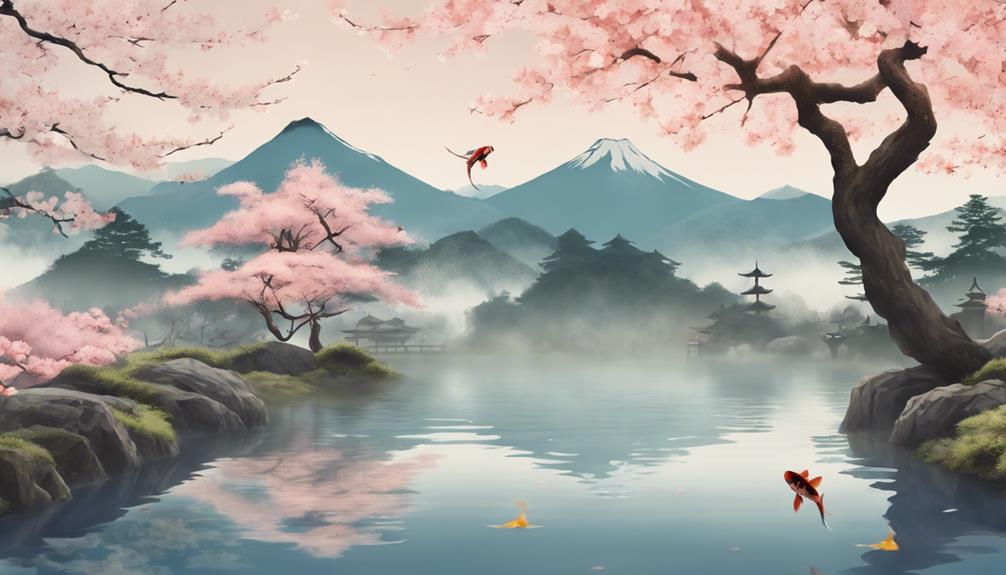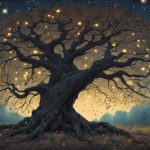As you explore haiku, you'll notice how this traditional Japanese poetry form captures the essence of nature, reflecting the Zen philosophy of impermanence and interconnectedness. Haiku poets masterfully weave natural imagery and metaphors to convey complex emotions and ideas, often using traditional landscapes to evoke serene and tranquil settings. You'll see how seasonal cycles and time are intricately woven into haiku, conveying the fleeting nature of life. As you continue, you'll uncover the profound environmental message and cultural significance of nature in haiku, inviting you to reevaluate priorities and adopt sustainable practices, and ultimately, discover the rich nuances of this ancient poetry form.
Nature's Inspiration in Haiku

One of the most distinctive features of haiku is its tendency to draw inspiration from nature, which you'll often find represented through imagery and metaphor. This inherent connection to the natural world is a hallmark of the genre, allowing haiku poets to tap into the subtle yet profound nuances of the Earthly domain. By exploring the intricate relationships between humanity and the environment, haiku poets can evoke a sense of interconnectedness, underscoring the importance of our earthly connections.
Through the careful observation of natural phenomena, haiku poets are able to distill the essence of nature, capturing the fleeting moments of beauty and wonder that surround us. This attention to natural nuances enables poets to convey complex emotions and ideas with remarkable simplicity, often relying on suggestion rather than direct statement. As you explore the world of haiku, you'll discover how masterfully poets weave together the threads of nature, human experience, and the fleeting nature of existence, creating a rich tapestry of meaning and symbolism.
Zen Philosophy in Haiku Poetry

As you explore the world of haiku poetry, can you uncover the subtle yet profound influence of Zen philosophy, which whispers secrets of impermanence, non-duality, and the fleeting nature of reality? This philosophical undercurrent permeates the haiku form, instilling a sense of mindfulness and spiritual connection in the poet and reader alike. Through the careful selection of words, haiku masters evoke the ephemeral nature of existence, echoing Zen's emphasis on the present moment. The quiet contemplation inherent in mindfulness meditation is mirrored in the haiku's concise, image-rich language, inviting the reader to pause and immerse themselves in the fleeting beauty of the natural world. As you explore further into haiku poetry, you'll discover that Zen's influence extends beyond the poem's content, influencing the very process of creation itself. The poet's task becomes a form of meditation, where the boundaries between self and nature dissolve, and the haiku emerges as a distilled reflection of reality.
Traditional Japanese Landscapes

In traditional Japanese landscapes, the subtle yet profound influence of Zen philosophy is mirrored in the carefully crafted haiku, which often evoke the serene and tranquil atmosphere of natural settings, such as misty mountains, serene gardens, and rustic villages. As you explore the world of haiku, you'll notice that these landscapes are often characterized by their simplicity, subtlety, and attention to detail. Mountain ranges, with their majestic peaks and valleys, serve as a backdrop for haiku that contemplate the human condition. Rural vistas, with their rolling hills and meandering streams, provide a serene atmosphere that encourages reflection. These landscapes are not mere backdrops, but rather integral components of the haiku, infusing the poetry with a sense of timelessness and connection to nature. By immersing yourself in traditional Japanese landscapes through haiku, you'll gain insight into the cultural and philosophical underpinnings of this unique poetic form.
Imagery of Seasons and Time

Two fundamental elements of haiku poetry, seasons and time, are masterfully woven into the fabric of traditional Japanese haiku, allowing you to experience the ephemeral nature of life through the poet's delicate handling of imagery. The incorporation of seasonal cycles, known as kigo, serves as a subtle yet powerful tool to convey the poet's message. By skillfully incorporating seasonal references, haiku poets evoke a sense of timelessness reflected in the cyclical nature of life. This mastery of seasonal imagery enables you to connect with the haiku on a deeper level, as the poet's words evoke a sense of shared human experience.
The haiku's concise structure allows the poet to distill the essence of a moment, capturing the fleeting nature of life. The juxtaposition of seasonal imagery with the poet's emotional response creates a sense of intimacy, drawing you into the haiku's quiet contemplation. As you immerse yourself in the haiku, you begin to appreciate the subtle nuances of seasonal cycles, and how they reflect the human experience. The poet's use of time and seasonality masterfully weaves together the ephemeral and the eternal, allowing you to grasp the essence of haiku poetry.
Haiku's Use of Natural Metaphors

Through the strategic deployment of natural metaphors, haiku poets masterfully convey complex emotions and ideas, inviting you to explore in a nuanced manner the human condition. By leveraging poetic personification, haiku poets imbue natural elements with human-like qualities, creating a rich tapestry of symbolic landscapes. This technique enables the poet to convey subtle emotional undertones, allowing you to intuitively grasp the intended sentiment. For instance, a withered leaf might symbolize the fleeting nature of life, while a serene mountain landscape might evoke a sense of inner tranquility. By tapping into the symbolic resonance of natural imagery, haiku poets craft a unique language that transcends linguistic and cultural barriers. As you engage with the world of haiku, you'll discover how natural metaphors serve as a gateway to the poet's inner world, offering a profound exploration of the human experience.
The Importance of Simple Language

While delving into the world of haiku, you'll find that simplicity of language is crucial, as it allows the poet to distill complex emotions and ideas into subtle, yet powerful, expressions. This simplicity enables haiku poets to convey nuanced sentiments without resorting to flowery language or elaborate metaphors. Instead, they rely on lyrical understatement, where the unsaid is often more significant than the said. This approach fosters a deeper connection between the poet and the reader, as the reader is encouraged to fill in the gaps and engage with the poem on a more intimate level.
Language clarity is essential in haiku, as it guarantees that the poet's intended meaning is conveyed without ambiguity. By using simple, concise language, haiku poets can convey complex ideas and emotions with precision, allowing the reader to grasp the essence of the poem quickly. This clarity also enables the poet to create a sense of intimacy and immediacy, drawing the reader into the poem's emotional landscape. By embracing simplicity, haiku poets can create powerful, evocative poems that resonate deeply with readers.
Cultural Significance of Nature

In Japanese culture, you'll find that nature is imbued with a profound symbolic significance, where seasons, landscapes, and creatures are often imbued with spiritual, philosophical, and emotional connotations that resonate deeply with the human experience. This cultural significance is deeply rooted in Shintoism and Buddhism, which emphasize the interconnectedness of humans and nature. You'll notice that nature is often depicted as a reflection of the human psyche, with changing seasons symbolizing the cycles of life and death.
Nature is also inextricably tied to Japan's national identity, with landscapes and creatures often serving as symbols of national pride and heritage. For example, the cherry blossom is a potent symbol of Japanese culture, representing the fleeting nature of life and the beauty of impermanence. This spiritual connection to nature has shaped Japanese aesthetics, ethics, and values, influencing the way people think, feel, and interact with the natural world. By exploring the cultural significance of nature in Japanese poetry, you'll gain a deeper understanding of the nation's values, beliefs, and sense of self.
Haiku's Environmental Message

As you explore the world of haiku, you'll discover that this traditional form of Japanese poetry conveys a profound environmental message, subtly yet powerfully highlighting the interconnectedness of human existence and the natural world. Haiku poets often emphasize the importance of living in harmony with nature, promoting eco-friendly lifestyles and sustainable living. Through their poetry, they encourage readers to adopt a more mindful approach to the environment, recognizing the delicate balance between human actions and the natural world.
In haiku, you'll find vivid descriptions of nature, which serve as a backdrop for exploring humanity's relationship with the environment. By focusing on the fleeting nature of life and the cyclical patterns of the natural world, haiku poets invite readers to reevaluate their priorities and adopt more sustainable practices. By embracing the simplicity and elegance of haiku, readers can cultivate a deeper appreciation for the natural world and a greater sense of responsibility towards the environment. Through its subtle yet powerful environmental message, haiku offers a unique perspective on sustainable living, encouraging readers to adopt eco-friendly lifestyles that promote harmony between humans and nature.
Frequently Asked Questions
Can Anyone Write a Haiku, or Is It Only for Poets?
You might wonder if writing a haiku is exclusive to seasoned poets. Not necessarily. While traditional haiku masters perfected the art form, beginners can also craft haiku that evoke creative freedom. Anyone can attempt to capture a moment or image in a few, well-chosen words. The key lies in embracing simplicity and clarity, allowing the essence of the moment to shine through.
How Do Japanese Haiku Differ From Western Poetry Forms?
You're probably familiar with Shakespeare's sonnets, but Japanese haiku is a different beast altogether. When you immerse yourself in haiku, you'll notice syllable counting is essential – 5-7-5 is the traditional rhythm. This strict format allows for nuanced exploration of cultural nuances, like the changing seasons or cherry blossom viewing. Unlike Western poetry, haiku's brevity and natural imagery create a distinct, contemplative atmosphere, making it a unique and mesmerizing form.
Are Haiku Only About Nature, or Can They Be About Anything?
As you explore the world of haiku, you might wonder if these poems are limited to nature themes. While traditional haiku often feature natural imagery, modern haiku has evolved to encompass urban landscapes and human emotions. You'll find contemporary haiku exploring cityscapes, technology, and personal experiences, demonstrating that haiku can indeed be about anything, not just nature.
Can Haiku Be Written in Languages Other Than Japanese?
As you journey into the world of haiku, you'll find yourself exploring a maze of syllables, where cultural nuances and linguistic barriers await. Can haiku be written in languages other than Japanese? The answer lies in the delicate balance between preserving the essence of haiku and transcending linguistic boundaries. While traditional haiku is deeply rooted in Japanese culture, modern adaptations have successfully bridged the gap, allowing haiku to flourish in diverse languages, albeit with careful consideration of the nuances that define this ancient art form.
Is Haiku a Dying Art Form, or Is It Still Relevant Today?
As you ponder the relevance of haiku in modern times, you may wonder if this traditional art form is fading away. However, with the digital revival of interest in traditional poetry, haiku's cultural significance is experiencing a resurgence. You'll find that online platforms and social media are revitalizing this ancient art, allowing new generations to engage with haiku and its timeless themes, ensuring its relevance endures.


